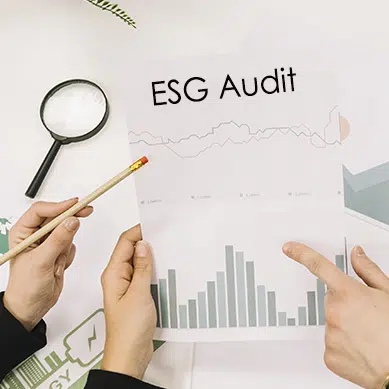Phone: +254 700 524589 | +254 782 524589 Email: [email protected]
The scope of an ESG (Environmental, Social, and Governance) audit is influenced by various factors including regulatory requirements, industry standards, stakeholder expectations, and the organization’s own sustainability goals. Here’s a deeper dive into the background of each aspect of the ESG audit scope:
Environmental Factors:
This aspect addresses the organization’s impact on the environment. Factors such as climate change, resource depletion, pollution, and habitat destruction are considered. With increasing global concern about environmental sustainability, organizations are under pressure to minimize their environmental footprint and adopt practices that promote conservation and responsible resource management.
Social Factors:
The social dimension of the audit focuses on how the organization interacts with its stakeholders. This includes employees, customers, suppliers, local communities, and society at large. Key issues may involve labor practices, human rights, diversity and inclusion, community engagement, product safety, and customer satisfaction. Ensuring positive social impacts and fostering healthy relationships with stakeholders are critical components of corporate social responsibility.
Governance Factors:
Governance encompasses the structures, processes, and policies that guide decision-making within an organization. Good governance practices ensure transparency, accountability, and ethical behavior. Areas covered in this aspect of the audit may include board composition, executive compensation, risk management, compliance with laws and regulations, anti-corruption measures, and shareholder rights. Strong governance is essential for building trust with stakeholders and sustaining long-term value creation.
Risk Management and Compliance:
ESG-related risks have become increasingly prominent on corporate agendas. Organizations face a range of risks including regulatory fines, reputational damage, supply chain disruptions, and litigation related to environmental and social issues. Effective risk management involves identifying, assessing, and mitigating these risks, as well as ensuring compliance with relevant laws, regulations, and industry standards.
Data Collection and Reporting:
Reliable data collection and transparent reporting are foundational to ESG auditing. Organizations need robust systems for gathering ESG-related data, analyzing performance metrics, and disclosing information to stakeholders. Accurate and comprehensive reporting enhances credibility and enables stakeholders to make informed decisions about the organization’s sustainability practices.
Benchmarking and Performance Comparison:
Benchmarking allows organizations to assess their ESG performance relative to peers and industry benchmarks. By benchmarking against best practices and key performance indicators, organizations can identify areas for improvement and set ambitious sustainability goals. Performance comparison also helps investors and other stakeholders evaluate the organization’s ESG performance and make investment decisions accordingly.
Integration with Business Strategy:
The integration of ESG considerations into business strategy is critical for driving sustainable growth and long-term value creation. ESG factors should be embedded throughout the organization’s operations, from strategic planning and product development to supply chain management and stakeholder engagement. A strong alignment between ESG objectives and business strategy enhances resilience, innovation, and competitive advantage.
Stakeholder Engagement:
Engaging with stakeholders is essential for understanding their concerns, priorities, and expectations regarding ESG issues. Organizations should establish effective communication channels, seek feedback from stakeholders, and respond proactively to their needs. Meaningful stakeholder engagement builds trust, fosters collaboration, and enhances the organization’s social license to operate.
Supply Chain Management:
The supply chain has significant environmental and social impacts, from raw material extraction to product disposal. Organizations need to assess ESG risks throughout their supply chain, promote responsible sourcing practices, and collaborate with suppliers to improve sustainability performance. Enhancing supply chain transparency and accountability is essential for mitigating risks and promoting ethical conduct among suppliers.
Emerging ESG Issues:
The landscape of ESG issues is constantly evolving, with new challenges and opportunities emerging over time. Organizations must stay abreast of emerging trends, regulations, and stakeholder expectations related to ESG. By anticipating and adapting to these changes, organizations can stay ahead of the curve and position themselves as leaders in sustainability and responsible business practices.
The scope of an ESG (Environmental, Social, and Governance) audit can vary depending on the organization’s objectives, industry, and regulatory requirements. However, generally speaking, the scope of an ESG audit typically includes:
Environmental Factors:
This involves assessing an organization’s impact on the environment, including its carbon footprint, energy consumption, waste generation and management, water usage, pollution control measures, and compliance with environmental regulations.
Social Factors:
This encompasses evaluating the organization’s relationships with stakeholders, including employees, customers, suppliers, and local communities. It involves examining issues such as labor practices, diversity and inclusion policies, human rights, community engagement, product safety, and customer satisfaction.
Governance Factors:
This focuses on the organization’s internal governance structures, policies, and procedures, as well as its transparency and accountability to stakeholders. Areas covered may include board composition and independence, executive compensation, risk management practices, ethics and compliance programs, anti-corruption measures, and shareholder rights.
Risk Management and Compliance:
Assessing the organization’s identification, management, and mitigation of ESG-related risks, as well as its compliance with relevant laws, regulations, and standards.
Data Collection and Reporting:
Reviewing the processes for collecting, analyzing, and reporting ESG-related data, including the accuracy, completeness, and transparency of disclosures.
Benchmarking and Performance Comparison:
Comparing the organization’s ESG performance against industry peers, best practices, and relevant benchmarks, in order to identify areas for improvement and opportunities for differentiation.
Integration with Business Strategy:
Evaluating the extent to which ESG considerations are integrated into the organization’s overall business strategy, decision-making processes, and long-term planning.
Stakeholder Engagement:
Assessing the organization’s mechanisms for engaging with stakeholders on ESG issues, including communication channels, feedback mechanisms, and responsiveness to stakeholder concerns.
Supply Chain Management:
Examining the ESG risks and opportunities associated with the organization’s supply chain, including supplier relationships, sourcing practices, and supply chain transparency.
Emerging ESG Issues:
Anticipating and preparing for emerging ESG trends, issues, and regulations that may impact the organization in the future.
For more details on sustainability reporting and training
Visit: https://sgb.ac.ke/ Enroll for Cohort 2 GRI https://sgb.ac.ke/gri-training/

